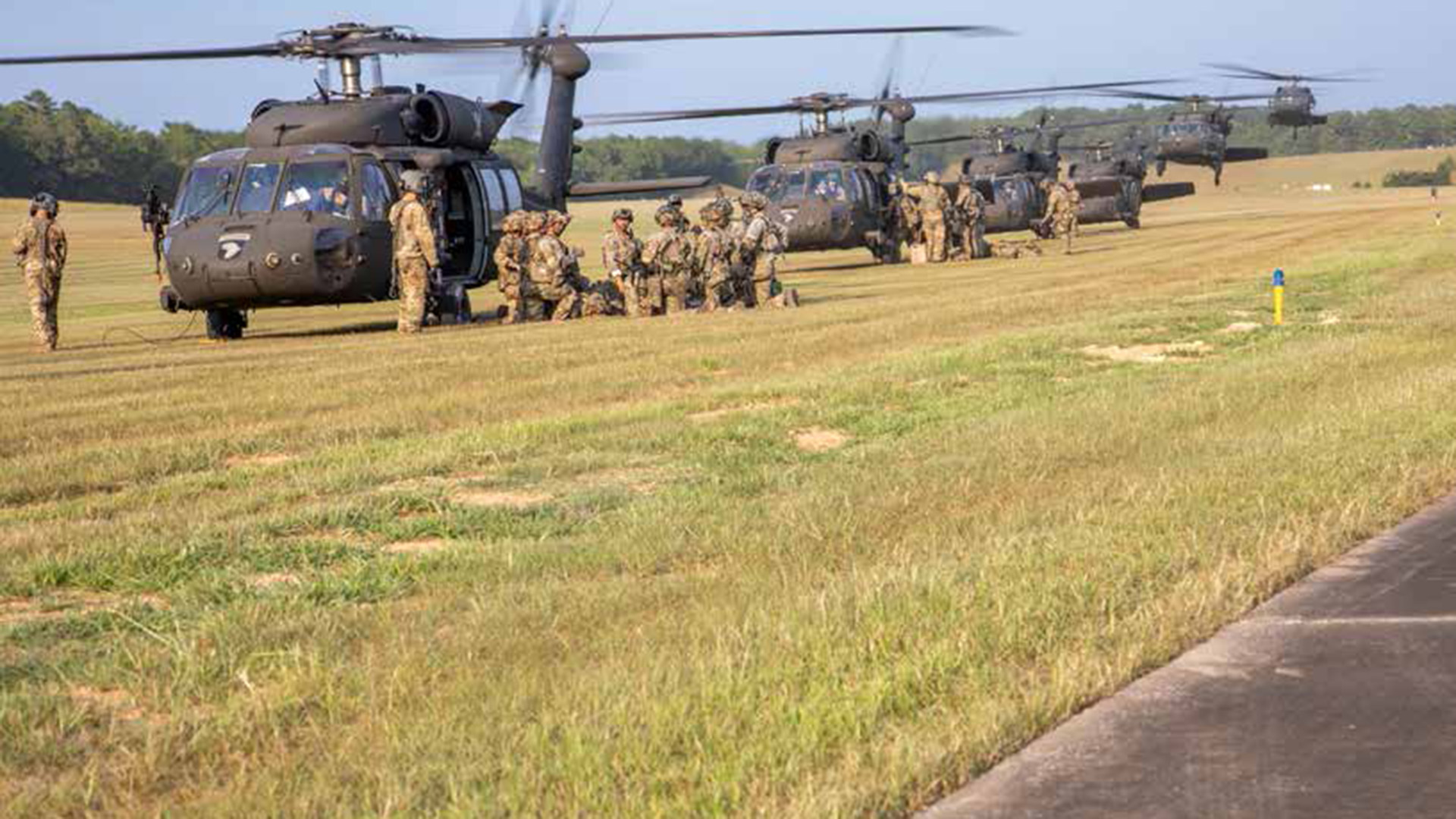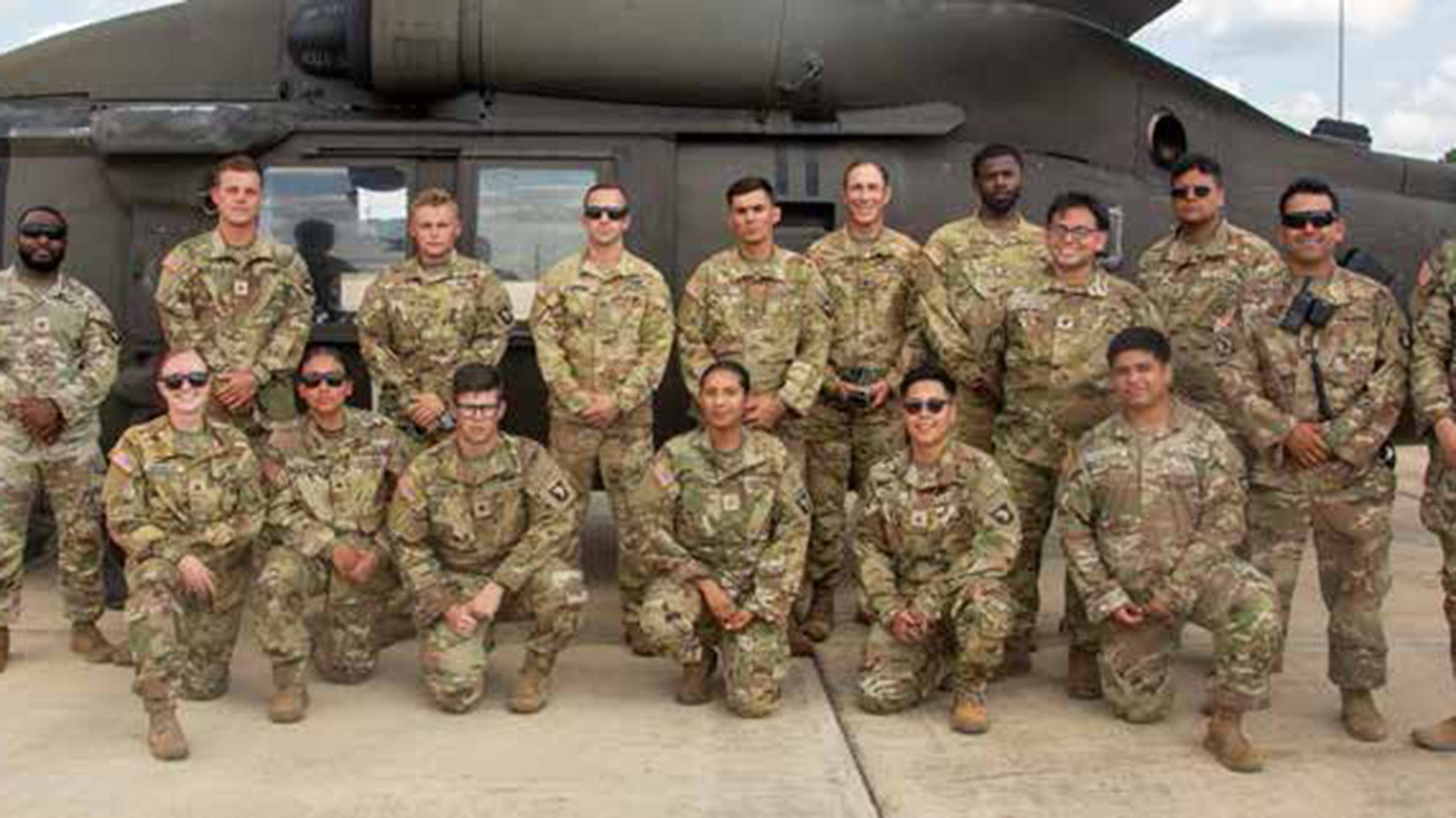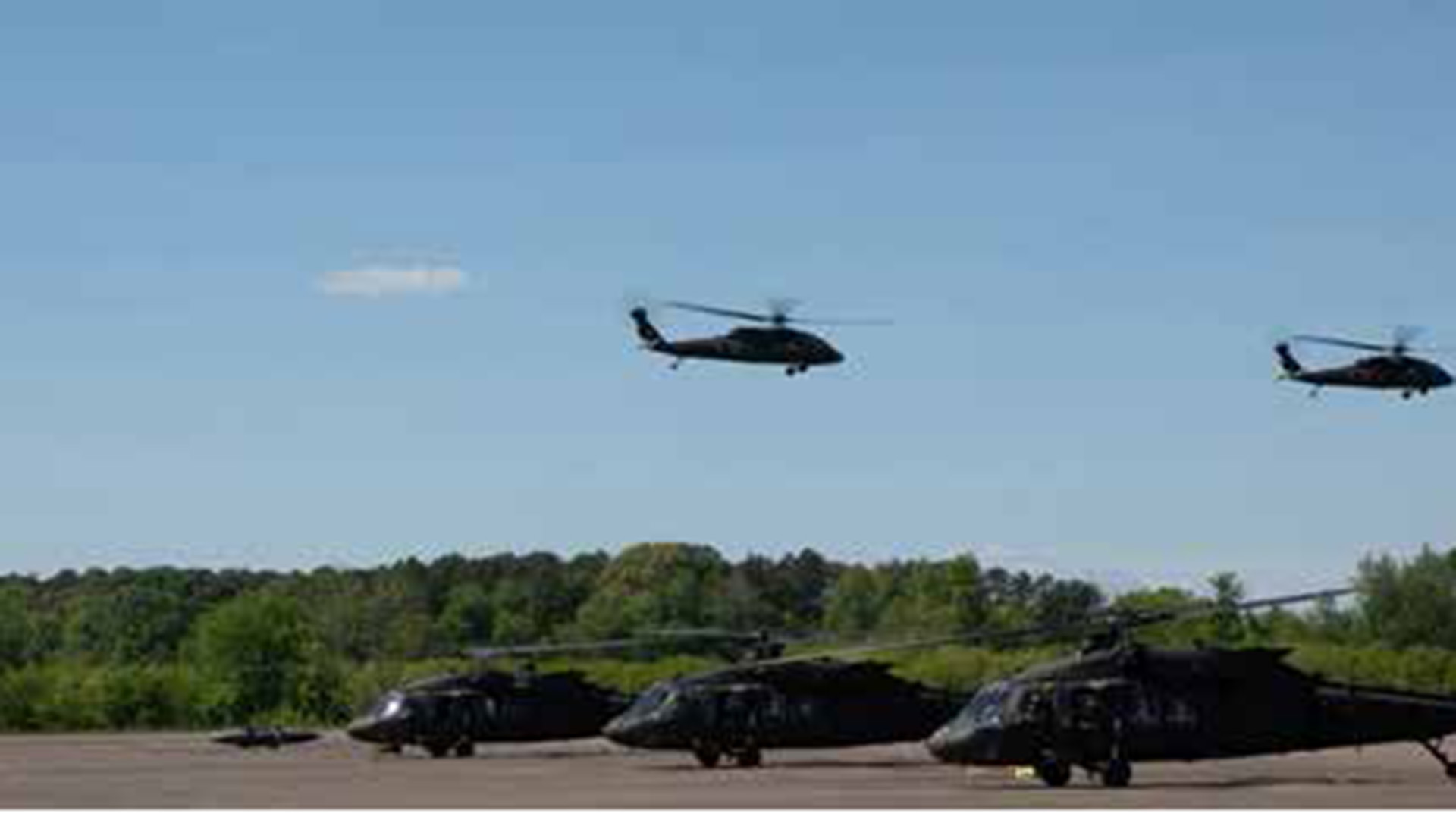Airspace Command and Control
Improving Army Aviation Lethality within Large-scale Combat Operations
By LTC Nicholas C. Currie
Article published on: October 1, 2024 in the Aviation Digest October-December 2024 Issue
Read Time: < 8 mins

The 101st Airborne Division (Air Assault) in Oxford, Mississippi. They are supporting 2D Mobile Brigade Combat Team “STRIKE,”at JRTC rotation 24-10 on Fort Johnson, Louisiana, during a large-scale, long-range air assault. U.S. Army photo by SPC Joseph Enoch.
In August 2024, Task Force "No Mercy" deployed to Fort Johnson, Louisiana, in support of the 2D Mobile Brigade Combat Team’s (2MBCT) Joint Readiness Training Center (JRTC) rotation 24-10. During the rotation, the aviation task force—as well as 2MBCT—learned valuable lessons regarding the process of updating and applying the Airspace Control Order (ACO) in support of Large-Scale Combat Operations (LSCO). The rotation underscored the importance of educating the force on Airspace Coordinating Measures (ACM) and controlling authorities for various types of airspace outside established ACMs and Fire Support Coordination Measures (FSCM), the need to rehearse the ACO submission/approval process during regular brigade/division level training windows, and the need to enhance the methods subordinate units (i.e., battalion and below) use to submit requests for inclusion into the ACO.
Background Doctrine Information
In accordance with Joint Publication (JP) 3-52, “Joint Airspace Control,” the ACO is an order that details approved requests for coordination measures such as ACMs, air defense measures, and FSCMs. It is published either as part of the air tasking order (ATO) or as a separate document. “The ACO defines and establishes airspace for military operations as coordinated by the Airspace Control Authority” (Chairman of the Joint Chiefs of Staff, 2010, p. II-5).
Within the ACO, Army Aviators will find ACMs and FSCMs to provide procedural control of a given portion of airspace. Most aviators are familiar with basic ACMs, including standard use Army aircraft flight routes (SAAFR), restricted operating zones, landing/pickup zones, the coordinating altitude, No Fly areas, coordinated fire line, fire support coordination line, phase line, free fire area, and kill boxes. However, few may know that JP 3-52 outlines nearly 100 different types of ACMs that could be included in the ACO (Chairman of the Joint Chiefs of Staff, 2010, Appendix C).
The process for updating the ACO is covered in the region’s Airspace Control Plan but generally requires units at echelon to submit requested ACMs and FSCMs to intermediate level airspace managers—usually found at the brigade level and above—who then consolidate, deconflict, and forward the requests to the region’s Airspace Control Authority by a specified time each day.
For Army Aviators who often fly below the coordinating altitude within a brigade combat team’s (BCT’s) area of operations (AO), the airspace outside of established ACMs and FSCMs is generally controlled by the BCT commander and staff in accordance with Field Manual (FM) 3-96, “Brigade Combat Team,” and FM 3-52, “Airspace Control” (Department of the Army [DA], 2021; DA, 2016). Control within a BCT’s air-space relies upon voice/digital communications between aircraft and airspace control elements to coordinate and integrate the actions of Army airspace users over an AO. Brigade combat team commanders exercise airspace management through control of airspace users, which is inherent in mission command to control assigned or supporting forces in all domains. In accordance with FM 3-52, “All Army airspace users transiting a brigade AO coordinate with the brigade responsible for the AO they are transiting” (DA, 2016, p. 2-9).
Case Study Lessons Learned
During JRTC 24-10, aviation task force leaders noted the average aviator and some BCT planners, as well as brigade aviation element (BAE) members, did not have a full appreciation of the ACO and its associated ACMs and FSCMs—a trend the Senior Aviation trainer and the Aviation Observer Controller (OC) team confirmed is becoming more common across multiple JRTC rotations within the last several years. This issue resulted in a less-than-optimal understanding of how to plan/submit ACMs to support a mission within a BCT’s AO—resulting in an ACO that often did not accurately reflect all known ACMs and FSCMs, as well as an inability for aircrews to fly through the BCT’s airspace without interfering with active gun target lines. Accordingly, this issue resulted in a lack of understanding among aircrews regarding whom they need to contact, as well as how to safely navigate airspace outside of established ACMs/FSCMs.
To bridge the knowledge gap, the aviation task force met face-to-face with BCT planners and the BAE to discuss the submission process, as well as how to best utilize Army Aviation to support the ground tactical plan. During this meeting, the team identified that the process by which ACO submissions were shared was not conducive to timely and accurate reporting. Due to a lack of an organic Tactical Airspace Integration System (TAIS) (a mobile airspace management system) at the battalion level, the aviation task force submitted ACMs and FSCMs via screenshots of Aviation Mission Planning Software (AMPS)1 and/or submitted AMPS draw files, which were not initially transferable by the BAE into TAIS. As a result, the BAE tried to replicate the screenshot to the best of their ability, resulting in significant inaccuracies in locations of ACMs and FSCMs, as well as simple omissions.
To rectify the issue of sharing ACM and FSCM submissions, the aviation task force started sharing specific coordinates for definable dimensions of each ACM and FSCM. While this process reduced error, it was time-consuming and overly cumbersome. After some research and troubleshooting, the team figured out how to import AMPS draw files into TAIS, reducing errors and man-hours required to process approvals, while enhancing the overall quality of ACO submissions.
In addition to improving the overall process by which ACO submissions were consolidated at the BCT level, the aviation task force invested heavily into improving integration with the BAE and brigade plans cell. Between forward positioning a liaison officer and conducting multiple face-to-face meetings, the task force helped gradually improve the quality of ACMs and FSCMs utilized by the BCT to maximize aviation freedom of maneuver in the AO without dramatically interfering with known gun target lines. A best practice was developing a series of SAAFR routes, which led to mutually supporting airspace coordination areas (ACA) in close vicinity to the BCT’s front line of troops. Each ACA provided enough maneuver space for a team of aircraft to operate at low altitudes, and the ACAs could be activated and deactivated as the team maneuvered throughout the AO to provide responsive aviation support.
One of the more interesting issues identified during the rotation was some confusion regarding the appropriate controlling authority for airspace located outside of established ACMs and FSCMs. Most senior aviators were familiar with the airspace command and control principles outlined in JP 3-52, FM 3-52, and FM 3-96, which identify the BCT AO owner as the airspace control element for any airspace outside of published ACMs and FSCMs. However, junior and mid-level aviators were not familiar with these principles—a trend also noticed by Aviation OC trainers across multiple JRTC rotations over the last few years.
To address this issue, the task force commissioned a group of aviators to study doctrine and develop a simple, yet effective, class to help teach the critical considerations every aviator should know regarding the ACO, ACMs, FSCMs, and coordination requirements for aircrews to operate within a BCT’s AO. The class will serve as a basic primer to drive future training and ensure aircrews remain well-prepared to operate effectively within the perceptively complex airspace associated with LSCO.
Going one step further, aviation units must conduct regular training events that incorporate a mock ACO to increase aviator familiarity and to exercise systems and processes necessary to submit updates to the ACO. Ideally, such training would require subordinate commands at the company and battalion level to submit ACO requests through their associated combat aviation brigade or BCT headquarters. In turn, the unit would continue to improve communication between AMPS and TAIS platforms, streamline communication protocols, and reduce the knowledge gap for aviators, as well as the BAE regarding airspace management principles. Once the mock ACO is published, aircrews could conduct training flights utilizing a mock SAAFR to reach an objective area, rehearse crossing phase lines or conducting a passage of lines with a BCT airspace manager, and integrating fires with ground-based fires assets.

Soldiers assigned to 101st Airborne Division (Air Assault) arrive at Oxford, Mississippi on August 13, 2024, en route to JRTC rotation 24-10. U.S. Army photo by SPC Joseph Enoch.
Airspace management within the construct of LSCO will only get more complex as technology and our advisories continue to evolve. Regular, consistent training of the basic principles surrounding the ACO, its associated ACMs and FSCMs, and the process by which ACO updates are applied will undoubtedly reduce the complexity for aviators and airspace managers alike. If such training is adequately resourced, our force will become more lethal and agile on the future battlefield—able to develop a mutually supportive airspace plan that is capable of delivering the full might and power of the Joint Force’s Sea, land, and air power to the enemy.

U.S. Soldiers from 5th Battalion, 101st Combat Aviation Brigade, 101st Airborne Division (Air Assault) take off in UH-60 Black Hawk helicopters to begin an L2A2. U.S. Army photo by PFC James Lu.
Notes
1. “The AMPS provides Army aviation state-of-the-art interoperability and mission planning tools to enhance situational awareness, command and control, and safety. AMPS automates aviation mission planning tasks, mission rehearsal, and flight planning” (Scott et al., n.d.)
References
Author
LTC Nick Currie is an AH-64D/E aviator and the commander of 1st Battalion, 101st Aviation Regiment, “Expect No Mercy,” headquartered at Fort Campbell, Kentucky. He has served in multiple leadership capacities at the platoon, company, and battalion level with the 101st combat aviation brigade (CAB) and 82D CAB.